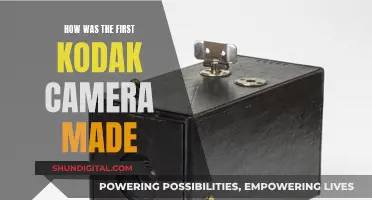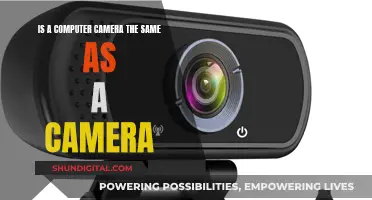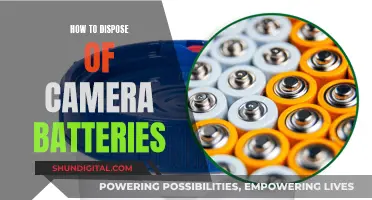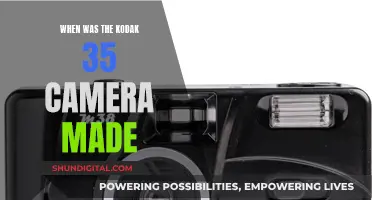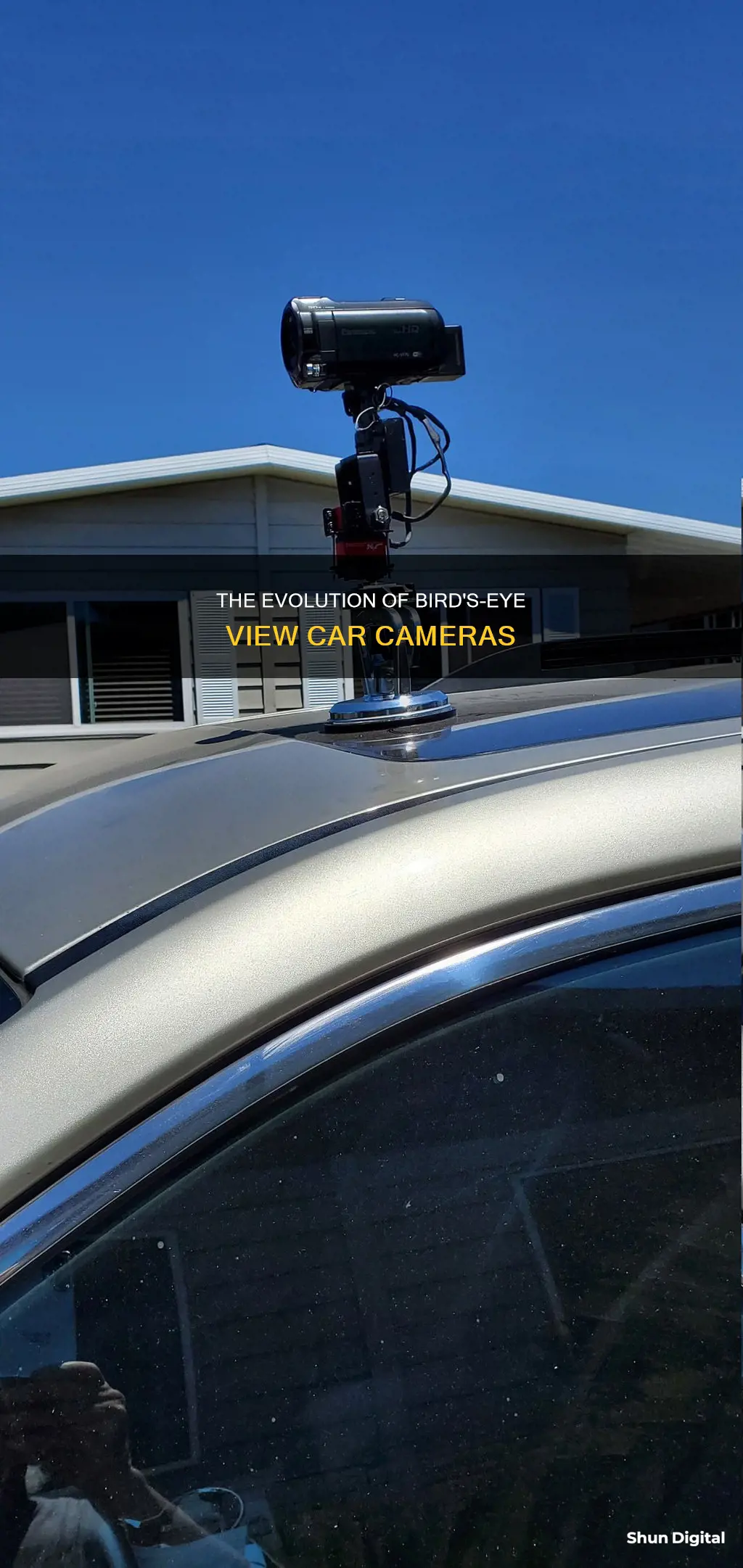
Cars with cameras that provide a top-down view of the vehicle and its surroundings are becoming increasingly popular. This technology, often referred to as a bird's-eye view or surround view, is achieved by stitching together footage from multiple cameras positioned around the vehicle. These cameras are typically mounted on the front grille, under the rear-view mirrors, and on the tail, providing a 360-degree view of the car's perimeter. The images are then processed and combined to create a seamless, coherent overhead image that is displayed on the vehicle's infotainment screen, often with a split-screen view. This advanced driver-assistance system not only enhances safety but also makes parking in tight spaces much easier. While this technology is currently offered as an expensive add-on by most automakers, it is expected to become more prevalent in the future, especially with the development of autonomous vehicles.
| Characteristics | Values |
|---|---|
| Number of cameras | 4-6 |
| Camera locations | Front grille, under rear-view mirrors, tail, side mirrors, grille or front fascia |
| Camera function | Provide a 360-degree view of the car and its surroundings |
| Display | Split-screen, with the top view of the car on one side and the front/rear/side view on the other |
| Alerts | Audio alerts to notify the driver of nearby objects |
| Use cases | Parking, off-roading, reversing, safety |
| Camera calibration | Intrinsic and extrinsic calibration |
What You'll Learn
- The cameras are placed in spots that enable the surveillance of the entire perimeter of the vehicle
- The image processor stitches together the individual images from each camera
- The display hardware shows the vehicle and its surroundings from a bird's-eye view
- The system is a valuable safety feature when parking
- The system is also useful for off-roading

The cameras are placed in spots that enable the surveillance of the entire perimeter of the vehicle
The 360-degree camera, also known as the Bird's Eye View or Surround View camera, is an advanced car feature that provides a comprehensive view of the vehicle's surroundings. This system is designed to enhance safety and improve the driver's awareness of their surroundings, bringing us one step closer to autonomous driving.
The 360-degree view is achieved by strategically placing multiple cameras around the vehicle, ensuring full coverage of the entire perimeter. These cameras are typically located on the front grille, under the side-view mirrors, and at the rear. This setup allows the cameras to capture footage of the surrounding area from different angles, providing a complete picture of the vehicle's surroundings.
The cameras work in conjunction with image processing software that stitches together the individual camera feeds to create a seamless, top-down view. This composite image is then displayed on the vehicle's infotainment system or touchscreen, often with a representation of the vehicle in the centre. The software also ensures that the brightness and colour of the individual camera views are matched, creating a coherent final image.
In addition to the cameras, proximity sensors play a crucial role in the system. These sensors use ultrasonic or electromagnetic technology to detect the distance to nearby objects. By emitting signals and measuring the time it takes for them to reflect back, the sensors provide accurate distance information, further enhancing the driver's awareness of their surroundings.
The placement of the cameras is a critical aspect of the system's design. Not only do the cameras need to be positioned to capture the entire perimeter of the vehicle, but they must also be integrated discreetly to maintain the vehicle's aesthetics. Therefore, engineers invest significant time in simulating different camera placements using CAD models to optimise the field of view and minimise blind spots, taking into account various vehicle load configurations.
Unlocking Privacy Shutter on Lenovo Camera: A Step-by-Step Guide
You may want to see also

The image processor stitches together the individual images from each camera
The image processor is a crucial component of the automotive surround view camera system, enabling drivers to have a bird's-eye view of their vehicle and its surroundings. This technology is a result of the evolution of automotive technology and Advanced Driver Assistance Systems (ADAS). The image processor takes individual images from each camera and stitches them together to form a cohesive, seamless, and real-time view.
The image stitching process involves several steps. Firstly, image registration detects key points on each image and assigns them to a common ground plane. This is followed by warping, where the undistorted image is deformed to match specific key points using techniques like homography or polynomial deformation. Finally, blending merges the individual images to obtain the final stitched image, with multiband blending providing the best resolution.
The image processor also employs geometric and photometric alignment processes. Geometric alignment includes lens distortion correction and perspective transformation, ensuring that the stitched image accurately represents the vehicle's surroundings. Photometric alignment matches the brightness and colour of individual camera views, creating a seamless final image as if captured by a single camera.
The result of this complex image processing is a top-down or bird's-eye view of the vehicle and its surroundings, projected onto the infotainment system screen. This technology enhances the driver's awareness, making parking and manoeuvring in tight spaces much easier and safer. It is a valuable feature, especially for larger vehicles, and contributes to the overall safety and convenience of modern automobiles.
Charging Your Canon 80D: A Quick Guide
You may want to see also

The display hardware shows the vehicle and its surroundings from a bird's-eye view
The display hardware, usually the infotainment system, shows the vehicle from a bird's-eye view, as if it were being filmed by a drone. This is achieved by stitching together the footage from several cameras positioned around the car, and using image-processing software to create a single, seamless, top-down image. The display also includes a representation of the car in the centre of the screen. This bird's-eye view is particularly useful when parking, providing a clear view of the vehicle's surroundings and helping the driver to avoid obstacles.
The infotainment system screen is split, showing the vehicle's top view on one side and the front, rear or side view on the other. This dual image is especially useful when parallel parking or pulling into a narrow parking space. The 360-degree camera system also includes proximity alerts, so that the driver can easily see and correct their course if there is an object behind the vehicle.
The number of cameras included in a 360-degree view car camera system varies, but there are usually between four and six wide-angle lens cameras integrated into the body panel of the vehicle. Typically, these are placed on the front grille, under the rear-view mirrors, and on the tail of the car. Side-view cameras may also be mounted on the outboard side mirrors. In addition to the rearview camera, a front fascia or grille camera captures the forward view.
The image-processing software takes the individual images from each camera and stitches them together to produce a cohesive, 360-degree view of the car and its surroundings in real time. This software uses algorithms such as geometric alignment, photometric alignment and composite view synthesis to create composite images.
Wireless Cameras: Charging Methods and Innovations
You may want to see also

The system is a valuable safety feature when parking
The 360-degree camera, also known as the Bird's Eye View or Surround View camera system, is an invaluable safety feature when parking. This technology is a composite of camera angles from several locations around the vehicle, joining to project an overhead view of the car and its surroundings. This system is especially useful when parking in tight spaces or when parallel parking.
The 360-degree camera system consists of 4-6 cameras with wide-angle lenses integrated into the body panel of the vehicle. These cameras are usually placed on the front grille, under the rear-view mirrors, and on the tail, providing a clear view of the vehicle's perimeters. The data from these cameras is sent to an image-processing module, which stitches the images together to form a cohesive view of the surroundings in real time. This composite image is then projected onto the vehicle's display screen, often the infotainment system.
The system also includes proximity sensors, which aid in evaluating the distance of nearby objects. These sensors send out ultrasonic or electromagnetic signals, and the time taken for these signals to reflect back indicates the actual distance between the car and the object. This information is crucial for manoeuvring into parking spots and avoiding obstacles.
The 360-degree camera system offers a split-screen view, displaying both the rearview and surround-view images. This dual image is incredibly useful when backing into a narrow parking spot, as it provides a clear view of any objects or people behind the vehicle. It also helps when pulling into a parking space in a lot or parking garage, making it easier to navigate and avoid obstacles.
The 360-degree camera is an advanced safety technology that enhances the driving experience, particularly when it comes to parking. It provides drivers with a comprehensive view of their surroundings, making parking safer and less stressful. This system is a valuable addition to any vehicle, improving visibility and reducing the risk of accidents.
Blackmagic Pocket 4K: Which Batteries to Use?
You may want to see also

The system is also useful for off-roading
There are various ways to configure a camera system for off-roading. One option is to have a pair of cameras mounted on the front bumper, facing downward to provide a clear image of the vehicle's path and the position of each tire relative to obstacles. Alternatively, a three-camera system can be used, with one camera facing forward from the centre of the grille or bumper and secondary cameras on the side-view mirrors or pods on the side of the vehicle, also facing forward to show the front wheels and the trail.
Off-road camera systems can also be customised to suit the specific needs of the driver and the vehicle. For example, a monitor that can display multiple images simultaneously is ideal for a multi-camera setup, allowing the driver to see objects around the vehicle without constantly switching between different camera views. Additionally, some cameras offer features such as night vision or thermal imaging, which can be useful for off-roading in low-visibility conditions.
Off-road camera systems not only enhance safety but also improve efficiency. With a clear view of the surroundings, drivers can more easily navigate challenging terrain and avoid obstacles, reducing the risk of accidents and damage to their vehicles. Overall, a camera system can provide valuable peace of mind for off-road enthusiasts, allowing them to focus on enjoying their adventure rather than worrying about potential hazards.
Cameras with Post-Focus: Capturing Moments with Creative Flexibility
You may want to see also
Frequently asked questions
The top-down view is created by stitching together the footage from multiple cameras placed around the car. The computer inside the car knows the angle, position, and field of view of each camera and uses this information to create a seamless bird's-eye view.
A 360-degree camera system provides a top-down view of the vehicle and its surroundings, making it easier and safer to navigate and park in tight spaces. It also includes features such as a split-view screen and proximity alerts, enhancing the driver's awareness of their surroundings.
A 360-degree view car camera system typically uses four to six cameras with wide-angle lenses, strategically placed on the front grille, under the side mirrors, and on the rear tail to capture the entire perimeter of the vehicle.
The image processing software uses algorithms such as geometric alignment, photometric alignment, and composite view synthesis to stitch together the individual images and create a seamless, coherent top-down view in real time.
Many automakers offer models with 360-degree camera systems, including Toyota, Nissan, Hyundai, Mitsubishi, Mercedes-Benz, BMW, and Tesla. While it is more common in higher-end models due to the cost, some lower-priced options are available, such as the Nissan Kicks and Altima.


